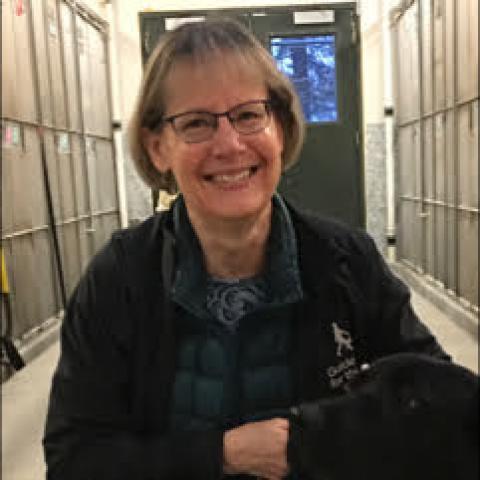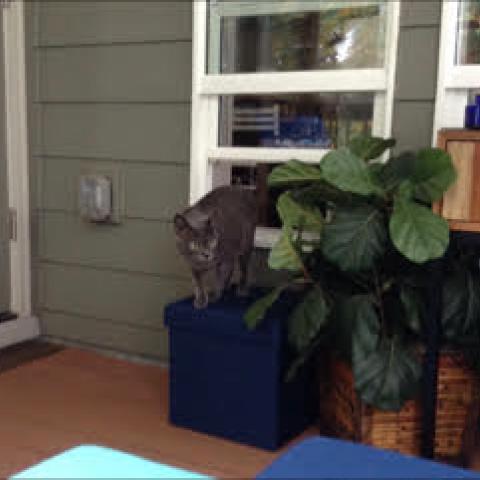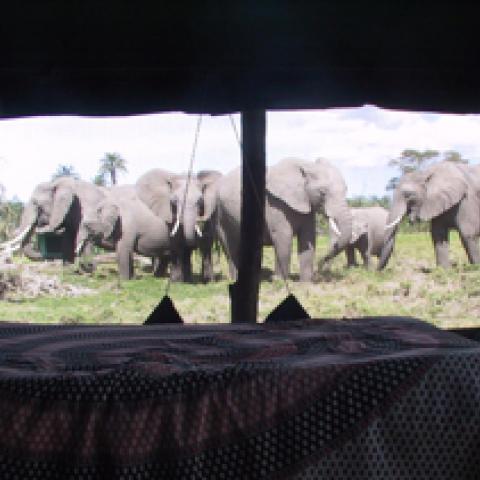Julie H. - September 2020 Volunteer of the Month
As a volunteer for MCAS in the cattery, kitten trailer, and as a foster, Julie H. feels like an extension of staff- because that’s the way staff have made her feel. Julie is driven by a desire to make a positive difference to care for animals, and brings a wealth of animal science knowledge and experience to her volunteer role, including a PhD in Biology from Duke University, and years of experience at the Oregon Zoo, and five years working at Guide Dogs for the Blind.
About the Volunteer of the Month
Pets Safe at Home
Growing up, Julie only had a few pets in the home. Her father had a Brittany Spaniel. She also remembers having two Siamese cats. When she was five years old, one of her cats was struck by a car in front of the house. This tragedy left a strong impression on Julie, who has advocated for keeping pets safe indoors her entire life- including guidelines set by Cats Safe at Home. Now, she maintains a catio for her thirteen year old cat, Sultan, who is leash trained, as was her previous cat, Wizard.
Early Work with Animals
Julie previously volunteered for the Oregon Zoo, before being hired as a floating zoo-keeper. She was placed in any habitat where she was needed, with the exception of working with wolves, and elephants. She also worked in Research and Education for the zoo. Julie enjoyed the variety of interactions she had with the many animals on site, and decided to continue her education to be able to do more.
Elephant Research
At Duke University, Julie started her education in Zoology, which later merged into the Biology department. Julie went on to earn her PhD in Biology.
The highlight of Julie’s education was a National Science Foundation funded research project she designed, on age, musth and paternity success in male African elephants.
Musth, unique to male Asian and African elephants, has at times wrongly been compared to rut in male deer. Unlike rut, it occurs asynchronously: it has no season. Moreover each individual male remains in musth for longer and longer periods as he ages and grows larger. Its characteristics include elevated testosterone level, temporal gland secretions, urine dribbling and increased dominance status over non-musth males.
Julie traveled to eighteen zoos throughout North America to observe and study the reactions of elephants to potential chemical signals communicated via urine from bull elephants during their musth and during in non-musth.
The second component of Julie’s project took her to Amboseli National Park in Kenya, to conduct the first research on the genetic paternity of elephants in the wild, and determine its correlation with bull elephants in musth. Because of the well-documented families of elephants in the park, Julie’s research benefited from a long history of knowledge about calves and their mothers. Julie verified the sires of 131 calves using DNA collected from over 500 individual elephants in the population. Julie’s research concluded that fathers were nearly ten times more likely to be in musth at the time of conception, although non-musth males did sire a small number of calves. Musth and prolonged indeterminate growth in male elephants are exceptional among mammals suggesting selection for longevity and extended reproductive success.
Back to Oregon
Julie intended to apply her professional knowledge and experience to wildlife conservation efforts at a place such as the San Diego Wild Animal Park, or similar facility. However, she returned to Oregon for family health reasons.
Ultimately, Julie just wants to work in areas that will be beneficial to animals and people. This drive brought Julie to work for Guide Dogs for the Blind, and to volunteer at Multnomah County Animal Services.
Julie works at the Boring, OR campus of Guide Dogs for the Blind, where she is a Canine Welfare Training Technician, caring for dogs in training when they are not with their instructors, as well as caring for boarding guides and career change dogs.
Cattery Volunteer
While Julie’s work is with dogs, her volunteer service has mostly been with cats. When Julie started volunteering in 2013, there was a great need for volunteers in the cattery, so that’s where Julie agreed to help. She worked her way through the beginning roles in the cattery, and was gradually given greater responsibilities. Now, Julie serves as a mentor for new volunteers. While she enjoys teaching new volunteers about safety, cat handling, and working with the public, her passion is working directly with the animals, especially long-term residents and senior cats. “The young cats generally get a lot of attention, and are adopted really quickly,” Julie says, “but you can tell that the older cats who have been there a long while really appreciate the touch and affection we give them.”
One of Julie’s favorite memories was when two cats were adopted after showing them to a young adopter who came to the shelter. A young woman came into the shelter, and told Julie that her mother was also there, but was staying in the car out of concern that she would want to adopt all the cats if she came inside. So her daughter was given the task of finding two cats- the one who was considered the hardest to adopt, and the one who had been in the shelter the longest. Julie showed her a cat with an amputated leg, and the longest-term resident. They were both adopted.
For Julie, it feels really good when any animal is adopted and gets to leave the shelter and go to a home. Because even with all the enrichment and personal touch volunteers and staff can provide throughout the day in the kennels, it’s no substitute for the comforts of home, rooms to roam, and a caring family.
Kitten Triage Trailer
Julie doesn’t remember exactly how she was enticed to volunteer in the kitten trailer, but she suspects she was recruited by foster volunteer Robynne R., or staff member, Jackie V.
“The kittens are all so cute, and I truly enjoy working with Jackie and kitten trailer volunteers, “ Julie says. “I don’t know why I started, but it sounded like it would be enjoyable. You never know what you’ll find in the kitten trailer- there could be only one kitten to care for, but you still have to stay, because litters of kittens could come through the doors at any time. Sometimes we do laundry on the side while we wait. Other days, all the kennels are full! The bottom line is that having dedicated people to care for kittens at the shelter assures their urgent needs will be met as soon as they come through the door, which saves lives.”
Rabbit Foster
When the campus of Julie’s work temporarily closed due to COVID-19 precautions, and Julie was working from home, she found herself with the time and capacity to take on foster animals for the first time, something she had never thought possible before. With MCAS also closed to adoptions, the need for foster care volunteers increased. Julie offered to foster, and was asked to foster rabbits. Julie asked for training and support, and Jen and Jodi gave her the tips and training she needed to be successful. Julie cared for a rabbit named Flossie from May through August, when Flossie was transferred to Oregon Humane Society (OHS), and adopted two days later.
Making Friends
Julie is grateful for the friends she’s made, and the positive relationships she enjoys while volunteering. In particular, Julie loves working with Jackie V. in the kitten trailer, Jen S. and Jodi. L. in foster care, Val and Chris who greet her when she arrives, and Tanya, Shelley, and many other friendly faces she recognizes but doesn’t know personally. Over the years, Julie is grateful for the support and company of many volunteers, including Robynne and Jackie R., Ray K., Darlene A., Jessica H., Ann G., Zach and Aurelia H., Malea S., and others on Friday volunteer shifts. Julie even "poached" Ann G. from the MCAS volunteers to work with her at Guide Dogs.
Thank you, Julie, for your volunteer service to care for the animals at Multnomah County Animal Services.


